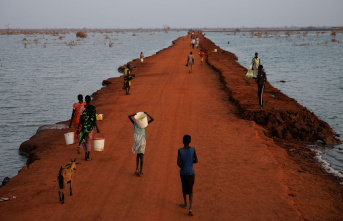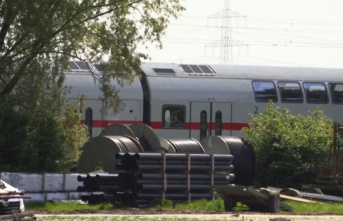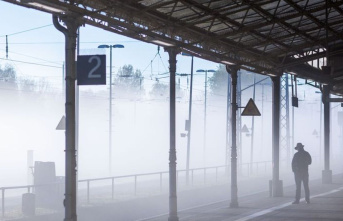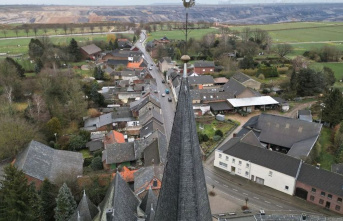The brand new paddocks of Circuit Gilles-Villeneuve, completed in 2019, have serious problems with water infiltration and drainage.
Jean-Louis Fortin, Office of Investigation
A confidential report commissioned by the Société du parc Jean-Drapeau (SPJD), of which our Bureau of Investigation obtained a copy, paints an unflattering portrait of the structure, which cost $60 million in public funds.
The study, prepared by the engineering consulting firm Groupe IRC, was commissioned by the SPJD in early 2021 "to determine the source of various active and historical infiltrations", we read at the outset in the report. about thirty pages.
Water seeps in and flows
Experts point to two main issues:
► In the closed portions of the building, there are several water infiltrations. One of the elements of the roof “is not waterproof; depending on the winds [and] precipitation, the water infiltrates [...] and flows on the interior facings of the building”.
"We are also told of water infiltration inside garages, at the location of the doors," reads another passage.
► In the bleacher floors exposed to the elements, water accumulates, because there is no slope that would allow it to evacuate.
“In various places, there is an accumulation of water on the service slabs. These are visibly level (with no visible drainage slopes). This element has been confirmed with the Architect, who confirms that the structural slabs and those of service have no slope. »
To add to the problem, the slabs exposed to the elements “simply weren’t [provided] with waterproofing,” notes the expert report.
Not to mention "that no drainage is provided at the level of the membrane [...] located on top of the structural slab".
Denounced during construction
According to our sources close to the matter, the problems related to water were raised even before the construction of the building was completed.
Builder Geyser alleges this in a $10.3 million lawsuit it filed last year against the SPJD for unpaid bills.
"The building's general lack of watertightness was denounced as early as June 2018, while the general lack of watertightness of the slabs and the design problems were mentioned", describes Geyser in a court document.
This litigation is far from over, because the SPJD considers these claims to be exaggerated. The general contractor claims in particular to have had to pay more than $2.5 million to speed up the construction site so that the building is ready in time for the 2019 edition of the Grand-Prix.
The SPJD did not want to comment on the paddocks, "given the judicial component".
WELLS WITHOUT SPENDING FUNDS
Whether on the circuit, in the paddocks, in the hospitality area or in the buildings necessary for the Grand Prix, the SPJD has spent tens of millions of dollars over the past five years. For example, turns 5, 6, 8 and 9 were resurfaced from 2017 to 2020 using "premium bitumen".
Total 87,8 M$
READ IN THE REPORT
Do you have information or documents of public interest? Contact me confidentially at: jean-louis.fortin@quebecormedia.com
The Canadian Grand Prix continues to take millions of taxpayers' dollars even though there has been no racing for two years.
François-David Rouleau, Office of Investigation
For 12 months, the Circuit Gilles-Villeneuve has required renovations of approximately $3.5 million.
A strong smell of fresh bitumen has hovered along the paddocks of the circuit for a few weeks. And for good reason: just over a month before the Grand-Prix, the pavers are active there over a distance of about one kilometer.
The work carried out by the Charex company has been completed, said the Société du parc Jean-Drapeau (SPJD). At the estimated cost of $2.8 million, we must also include the replacement of the drain in front of the garages and the renovation of the starting platforms.
This work is being carried out after only one run since the 2019 paving. By the time the new paddocks were delivered, the pit line had by then been surfaced. The 2020 and 2021 editions of the Grand-Prix have been canceled due to the pandemic.
Why do we already have to redo everything?
“The work is in line with the recommendations of the International Automobile Federation (FIA),” said Kaven Gauthier, public relations adviser at the SPJD, by email.
Last year, the “Pirelli Tower”, a building located at the exit of the hairpin and which serves as a race medical center, required renovations of $348,000 for the repair of the roof and the stairs.
"The building had a high index of dilapidation and had to be maintained according to the maintenance of our assets," suggested the SPJD.
A money pump
In May 2021, our Bureau of Investigation had listed public investments of $91 million on Île Notre-Dame since 2017.
These expenses do not include the annual amount that the three levels of government must pay to Formula One World Championship, owner of the F1 championship. This year, that fee is about $20 million. It will climb to $26 million in 2031, the last year of the agreement.
The 2022 event, which will be held from June 17 to 19, also marks Bell's entry into the scene as promoter of the event.
The telecommunications giant took over Octane's contract in the spring of 2021. The latter company, headed by François Dumontier, still continues to oversee the organization of the race.
Same places
Since 2017, the SPJD has notably invested nearly $7 million in redevelopment and resurfacing work on the 4.36 km track.
In 2019, each of the 14 corners of the circuit had been repaved according to FIA requirements. Some were further corrected the following year.
And it's not over.
The City of Montreal's Ten-Year Capital Assets Program (PDI) provides for investments of $226.8 million in Parc Jean-Drapeau until 2031. Some of them, the amounts of which are not defined for the moment, will be used for the buildings and the resurfacing of the circuit.
Montreal Mayor Valérie Plante sees no problem investing millions of dollars each year in a motor racing circuit, even if she regularly takes pro-environment positions.
François-David Rouleau, Office of Investigation
No later than April 25, Ms. Plante signed a treaty against the exploitation of fossil fuels.
His administration also aims to reduce greenhouse gas emissions in the metropolis by 55% by 2030.
According to his press secretary, Catherine Cadotte, there is no contradiction between the signing of such a treaty and public investments to allow a race of gasoline cars.
“The signing of the treaty supports the non-proliferation of fossil fuels and the cessation of the exploitation of new energy sources. It is not related to [oil] consumption,” she explained.
Last year, when the extension of the Grand Prix agreement was announced until 2031, Valérie Plante also defended the international event, stressing that it "is a unique tourist event for the city, particularly in because of the major economic benefits”.
Towards carbon neutrality?
In 2019, the great F1 circus estimated that it emitted 256,000 tonnes of carbon dioxide per racing season, the equivalent of 88,000 cars traveling 20,000 km per year.
The logistics for transporting equipment from country to country were responsible for 45% of the emissions, while the team installations emitted 19.3%.
Concerned about its environmental impact, F1 unveiled its plan in 2019 to be carbon neutral by 2030.
To achieve this, she wants to reduce her waste to zero. It also aims to maximize its logistics and the efficiency of its travels around the world.
This season, 22 races are on the calendar, like last year. Peaks in the history of F1.
From March to November, the circuit travels across five continents and crosses the planet's oceans nine times.
1












